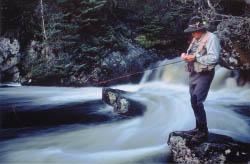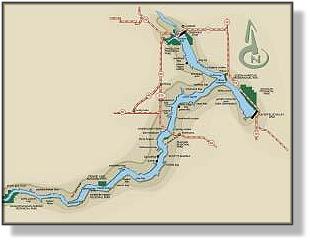Saskatchewan's Inland Sea
Lake Diefenbaker

By Chris Marshall from conversations
with Bob Sheedy
Bob Sheedy Photos
I've never even seen Lake Diefenbaker, let alone fished it. But 39 years ago I remember
fishing in the South Saskatchewan River close to the bridge where Highway #4 crosses
it just north of Stewart Valley. I was newly arrived from England and used the float gear
I'd brought with me to fish a worm in the streamy water. All I caught were suckers, but
to me they were a new and exotic species and, therefore, a delight.

Today, those stony rapids are long gone, drowned by the water of Lake Diefenbaker, a
huge im-poundment in southern Saskatchewan. It was completed in 1967 by building two
dams - one on the South Saskatchewan River (at 5,000 metres long and 64 metres tall,
one of the largest earthfill dams in the world), and one on the much smaller Qu'Appelle
River 45 kilometers to the south-east. The result is a long, thin lake winding up the course
of the South Saskatchewan River valley for 225 kilometers, with scores of flooded coulees
indenting the banks. That translates into nearly 800 kilometers of shoreline. It's perfect
habitat for Saskatchewan's two principal sport fish - walleye and pike. And these are
what Lake Diefenbaker is primarily known for: it's a haven for hardware chuckers.
But that same undulating shoreline and the cool (16%-20% Celsius), clear water are
also the perfect recipe for trout. These, and schools of oversize native goldeyes, have
begun to attract fly fishers in increasing numbers. One of these, Bob Sheedy, who has
fly fished the lake for several years, is the primary and immediate source of the
information which follows.
Trout
The trout fishery on Lake Diefenbaker has always been incidental to the walleye
fishery. In fact, its biggest boost happened a few years ago when a controversial
court ruling required a major trout farm on the lake to release its entire stock of
rainbows. Since then, the stocks of rainbows have been augmented by a steady
stream of escapees from other hatcheries and from a modest, but growing, stocking
programme by the provincial government. Today, fly fishers regularly take rainbows
in excess of 20 inches, and last year a 27 pound specimen was landed by an angler
trolling for walleye.
But not all the rainbows come from hatcheries. As the South Saskatchewan River
is fed by the Oldman and Bow Rivers, it's inevitable that a number of rainbows and
browns will drop downstream and take up residence in the forage-rich, cool, clear
waters of the lake. The browns are not numerous, but they're big - sometimes very
big. There's a story of a 37 pound monster being killed by a spear gun in 1997.
The lake also holds lake trout, but these are less likely to feed on or close to the
surface as rainbows and browns do. Therefore, they are only incidental targets
for fly fishers.
Goldeye
 The first fish I caught in Canada was a goldeye, back in 1960 on the North
Saskatchewan River in Saskatoon. It took a grasshopper which I fished with
float gear in the streamy water below a dam on the western outskirts of the city.
As a newcomer to Canada, having arrived from England only days before, I found
it an exotic catch. However, I suspect that most Canadian anglers who live outside
the prairie provinces would feel the same way. Not many fly fishers have ever
deliberately fished for goldeye, or even ever seen one.
The first fish I caught in Canada was a goldeye, back in 1960 on the North
Saskatchewan River in Saskatoon. It took a grasshopper which I fished with
float gear in the streamy water below a dam on the western outskirts of the city.
As a newcomer to Canada, having arrived from England only days before, I found
it an exotic catch. However, I suspect that most Canadian anglers who live outside
the prairie provinces would feel the same way. Not many fly fishers have ever
deliberately fished for goldeye, or even ever seen one.
Yet the goldeye is a perfect fly fishers' fish. It rises freely to dry flies and hits
streamers and bucktails with savage enthusiasm. It tailwalks readily when hooked
and is far less easily spooked than trout. On Lake Diefenbaker, the average size
is around 12 inches, but specimens can hit 20 inches plus.

Locating The fish
Although Lake Diefenbaker is huge, finding the fish is not difficult. Much of the main
shoreline shelves steeply into deep water and provides little in the way of fish-attracting
structure. This means that the highest concentrations of both trout and goldeye occur in
and close to the narrow bays created by the flooded coulees. It is here that most of the
bars, ledges, weed beds, and rocky points on the lake are found. Shoals of emerald
hiners and other forage fish live in and around the cover provided by these structures,
and that's where the trout and goldeye hunt them.

Water levels are also a major factor in determining where fish, particularly rainbows,
locate. Levels are allowed to rise in June, until they stabilise towards the end of the
month. As the water rises, it floods the bankside vegetation, much of it dense swathes
of yellow canola overflowing from adjacent fields. Trout and goldeye, forage in pods,
driving baitfish right into the submerged vegetation. Similar action can be found off the
points of the coulees where baitfish also congregate.
 In the fall, as the water cools, baitfish seek out pockets where sun-warmed shoreline
structure, especially rocks, raises the water temperature. Opportunistic rainbows make
the most of this. The rock-lined edge of the embankment of the Gardiner Dam, which
faces south-east, is one of the top hot spots.
~ Chris Marshall
In the fall, as the water cools, baitfish seek out pockets where sun-warmed shoreline
structure, especially rocks, raises the water temperature. Opportunistic rainbows make
the most of this. The rock-lined edge of the embankment of the Gardiner Dam, which
faces south-east, is one of the top hot spots.
~ Chris Marshall
Concluded next time!
|





